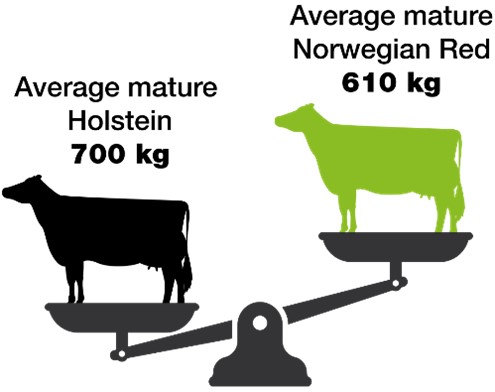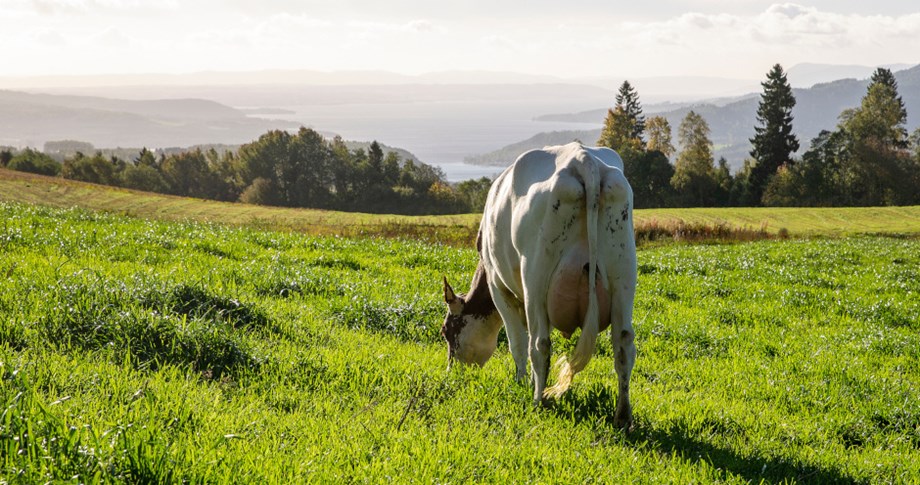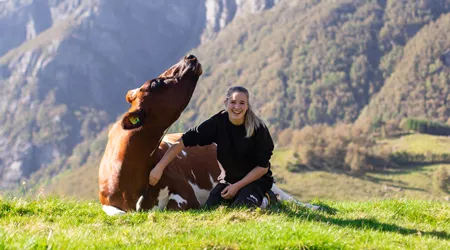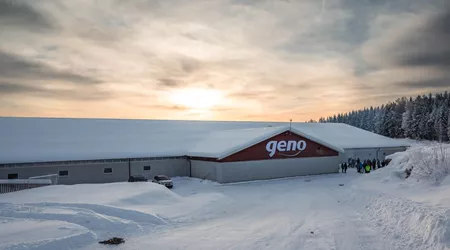By Dr. Gary Rogers
Feed costs represent one of the largest costs for dairy production. Genetic change to reduce cow feed requirements will improve dairy herd profitability and make dairy production more environmentally friendly and sustainable.
Geno has launched two new traits to help dairy producers select Norwegian Red sires with lower expected feed requirements. The traits being introduced are mature body weight (live weight) and expected feed requirement for body weight maintenance, called Feed$aved™.
Cow size or body weight matters
Larger cows need more feed for maintaining body weight so many key dairy populations around the world are trying to select for smaller cows. In general, body weight has low correlations with other key traits in the breeding goal of most populations, so these low correlations allow for selection for lower body weight without creating undesirable change in other key traits.
Norwegian Red cows are smaller than Holsteins. This makes Norwegian Red very attractive from a feed efficiency perspective. Average purebred Norwegian Reds mature at about 610-615 kg whereas average Holstein cows in most major dairy countries mature at about 700 kg.
Crosses between Norwegian Red and Holsteins average about 655 to 660 kg at maturity. We do find many variations in body weights within the breeds, so this lets us select smaller and more efficient cows within the Norwegian Red and other breeds.

Figure 1: Average purebred Norwegian Reds mature at about 610-615 kg whereas average Holstein cows in most major dairy countries mature at about 700 kg.
Mature body weight
The new mature body weight trait (or live weight) is calculated from about 1.2 million slaughter records on Norwegian Red cows. The carcass weights are used to predict mature body weight using a formula developed by the Geno Research and Development team. This prediction of body weight from carcass weights accounts for age and lactation number as well as carcass classification and fat classification. In general, tall and thin cows have carcass weight that is a lower percentage of body weight (live weight) compared to heavier muscled cows with higher body condition.
Breeding values (BV) for mature body weight and Feed$aved are available on all Norwegian Red sires. These BV for mature body weight is used to determine the new Feed$aved™ trait. Mature body weight and Feed$aved™ have excellent accuracy due to a large number of records available and the high heritability for mature body weight.
Genetic evaluations for Feed$aved™
Genetic evaluations for Feed$aved™ will be published in the form of Predicted Transmitting Abilities (PTA) which is unlike other genetic evaluations on Norwegian Red sires. All other traits in the Norwegian Red breeding program are published as standardized BV with a base population set to 100 and a standard deviation of 12 points. In addition, the PTA for Feed$aved™ will have the base defined as a 700 kg cow.
This allows for easy interpretation of the sire PTA for Feed$aved™ as the new PTA will reflect the expected feed savings from daughters of a sire when he is mated to a 700 kg cow. Because Norwegian Reds are generally smaller than 700 kg of body weight the new PTA will illustrate the expected benefit in feed savings when Norwegian Red sires are mated to average Holstein cows.
How much can you save?
The average PTA for the new Feed$aved™ trait will be 0.65 kg, which indicates that the average Norwegian Red sire will produce daughters that will eat 0.65 kg less dry matter per day due to smaller bodyweight when mated to a 700 kg cow. Typical feed costs in the United States are about $0.26 per kg of feed dry matter and typical feed costs in the UK are about 0.20 UK Pounds per kg which works out to be about $62 per cow per year or about 47 UK Pounds per cow per year in savings. The smaller Norwegian Red by Holstein crosses compared to pure Holsteins can result in huge differences in profit for dairy herds.
The top Norwegian Red sires for Feed$aved™ will have PTA that is slightly over 1 kg. This indicates that daughters of the best Norwegian Red sires for Feed$aved™ from Holstein dams will eat over 1 kg less per day due to smaller body weight. This would be a saving in feed costs of around $100 per cow per year in the United States or 73 UK Pounds per cow per year.
How to use the Feed$aved™ trait
The new Feed$aved™ trait will be used to select Norwegian Red bulls to improve the feed costs associated with maintenance of body weight. Herds using Norwegian Red sires can use the new Feed$aved trait as part of a selection index designed to choose the best Norwegian Red sires for the local herd circumstances.
Herd owners and managers will be tempted to eliminate bulls with below-average PTA for Feed$aved™. However, this could be a mistake as many other traits are still important in crossbreeding programs. Requiring PTA for Feed$aved™ to be average or higher could eliminate some outstanding sires that are just slightly below average for Feed$aved™. Several traits will continue to be important for the selection of our Norwegian Red sires for crossbreeding but now herds will have a new tool in the toolbox to use in making better sire selection decisions.



